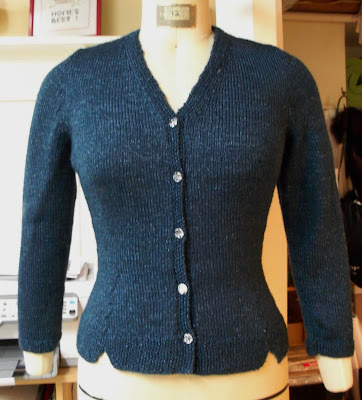Here is the muslin for my Eva Dress Contest entry.
I love this blouse. I was a little surprised by the amount of fullness in the sleeve cap and initially thought I would reduce it a touch. But that would not be holding to the rules of the contest....and when I tried it on, it just looked great! I love the way the neckline curves up onto the neck, don't you?
Chuck says "Wow! That is perfect for you...very nice"
I am pleased and looking forward to making it up in my wool challis.
Now about the pattern....
The instructions for sewing the neckline facing and attaching the lower bodice to the upper bodice are .....out of date, although possibly easier then how I chose to do it. There is not a separate neck facing, just extensions along the front and back neck edge that get turned back and blind hemmed in place.
The instructions want you to overlap the shoulder seam - meaning fold back the seam allowance along the back shoulder, gather the front shoulder, Lay the folded back shoulder onto the front shoulder and edge stitch.
Here you can see the Blouse back, at least one shoulder and half of the neck.
I stay stitched the edge, clipped into it and placed the front shoulder to the back shoulder with right sides together and stitched. It is a bit tricky getting around that turn, similar to a shawl collar. Once both shoulder lines are sewn you can turn your facing back and blind stitch as suggested.
This technique is repeated to attach the lower blouse front to the upper, but again I placed right sides together and stitched. You could certainly add the edge stitching after, if you like the look.
This technique is repeated to attach the lower blouse front to the upper, but again I placed right sides together and stitched. You could certainly add the edge stitching after, if you like the look.
From here I will play with the gathering distribution on that sleeve cap, this might have been a misunderstanding of the patterns marks on my part.
Can you see the difference between the illustration and my muslin? Yikes!
Can you see the difference between the illustration and my muslin? Yikes!
I also need to adjust the sleeve hem and placket which is simplicity itself as it has no placket piece, but has you create a placket from the under arm sleeve allowance and using hem tape to finish. For authenticity's sake I will finish it that way. The hem line though is uneven forming a peak at that underarm seam, which needs to be leveled out. This might have occurred when I adjusted the length of the sleeve....I will be sure to post a tutorial on how to fix that simple and commonly found error.


















































